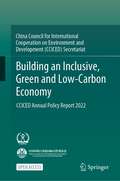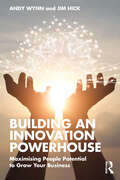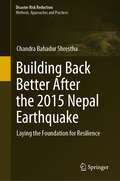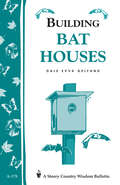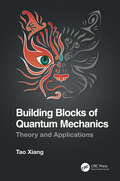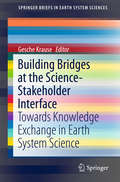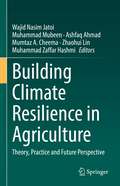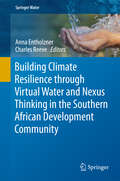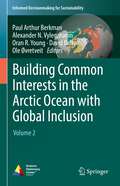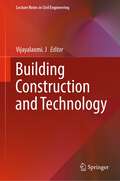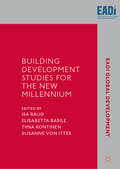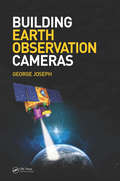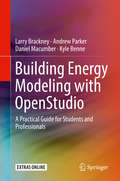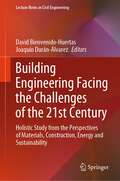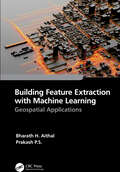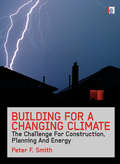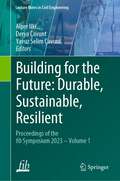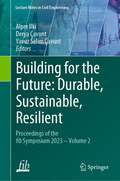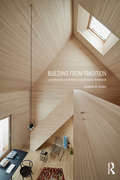- Table View
- List View
Building an Inclusive, Green and Low-Carbon Economy: CCICED Annual Policy Report 2022
by CCICEDThis open access book introduces the major environmental green development issues from six major themes carbon neutrality, nature-based solution, watershed management and climate adaptation, BRI green development, sustainable food supply chain, ecosystem-based integrated ocean management focusing on the progress of China’s environment and development policies from 2021 accomplishments. It is based on the research outputs of CCICED in the year of 2021, which marks China’s start point of implementation of its 14th Five-Year Plan when world economy also strived to recover from the pandemic.
Building an Innovation Powerhouse: Maximising People Potential to Grow Your Business
by Andy Wynn Jim HickIn Building an Innovation Powerhouse you will learn how to maximise the potential of people to grow your business. Authors Andy Wynn and Jim Hick dive deep into the most complex aspect of innovation and skilfully deconstruct the multi-dimensional complexities of working with people to reveal the secrets of how to handle the challenges of innovation. Building an Innovation Powerhouse uncovers the inner workings of industry giants, including Boston Consulting Group, Google, Hexcel, Kennametal, DuPont, CeramTec, Novartis, and many more, and explains exactly how these organisations and their leaders have motivated people to create a culture of innovation. A roadmap clearly sets out change in the following:1. Culture – how to guide an organisation to work holistically.2. Teams – how to ensure collaboration is laser-focused on business growth.3. Individuals – what people can do to become more creative and contribute to business success.4. Diversity – how to develop the right mix of skillsets, backgrounds and viewpoints.5. Leadership – what business leaders need to do to ensure that all levels of the business are heading in the right direction and delivering growth. Written with true insight by renowned leaders in their fields and enhanced by valuable case studies and contributions from numerous senior executives who have a real passion for stimulating innovation to drive business growth, this book is essential reading for businesses looking to transform into an innovation powerhouse.
Building an Innovation Powerhouse: Maximising People Potential to Grow Your Business
by Andy Wynn Jim HickIn Building an Innovation Powerhouse you will learn how to maximise the potential of people to grow your business. Authors Andy Wynn and Jim Hick dive deep into the most complex aspect of innovation and skilfully deconstruct the multi-dimensional complexities of working with people to reveal the secrets of how to handle the challenges of innovation. Building an Innovation Powerhouse uncovers the inner workings of industry giants, including Boston Consulting Group, Google, Hexcel, Kennametal, DuPont, CeramTec, Novartis, and many more, and explains exactly how these organisations and their leaders have motivated people to create a culture of innovation. A roadmap clearly sets out change in the following:1. Culture – how to guide an organisation to work holistically.2. Teams – how to ensure collaboration is laser-focused on business growth.3. Individuals – what people can do to become more creative and contribute to business success.4. Diversity – how to develop the right mix of skillsets, backgrounds and viewpoints.5. Leadership – what business leaders need to do to ensure that all levels of the business are heading in the right direction and delivering growth. Written with true insight by renowned leaders in their fields and enhanced by valuable case studies and contributions from numerous senior executives who have a real passion for stimulating innovation to drive business growth, this book is essential reading for businesses looking to transform into an innovation powerhouse.
Building Back Better After the 2015 Nepal Earthquake: Laying the Foundation for Resilience (Disaster Risk Reduction)
by Chandra Bahadur ShresthaThis book explores the reconstruction after the 2015 Gorkha Nepal earthquake, on the basis of the author’s first-hand experience that has been validated with empirical evidence. Unlike other advocacy and academic literature, the book takes readers close to the ground where the activities took place. This book describes Nepal’s efforts to rebuild private housing from the preparatory to the concluding stages, and the obstacles faced and overcome along the way. It assesses the consequences of the policy level decisions and also examines the relevance, utility and future use of damage assessment surveys that were carried out in the country. In addition, lessons from the housing grant payment through the banking system, impending reasons for housing non-compliance to building standards, experimentation with resilient resettlements and unresolved issue of urban regeneration have been also delved in. The ground realities revealed that the aid architecture requires further carving out. The last three chapters have attempted to capture the macro level picture of the reconstruction and recovery endeavors: contribution to national economy, structural resilience and comparative overview of Nepal’s delivery in global context. As an intimately involved professional with the 2015 Nepal Earthquake, Dr Shrestha is the authority from whom a holistic understanding can be attained regarding the response of Nepal's state and society to the Earthquake. His study will have ramification at national and global scale in handling with inescapable natural calamities. Kanak M. Dixit, Journalist and Heritage ConservationistDr. Shrestha’s book provides rare insight and perspective on the issues and challenges of governance during the complex journey to reconstruction and future resilience, reflecting his long and intense engagement in the post disaster recovery and reconstruction. Vivek Rawal, Director, People-in-Centre, Ahmedabad, India This collection of balanced insightful essays methodically explores topics such as government decisions and aid during the earthquake recovery combining lived experience and a research approach to reveal lessons and future considerations. Loren Lockwood, Former National Coordinator, &n
Building Bat Houses: Storey's Country Wisdom Bulletin A-178 (Storey Country Wisdom Bulletin)
by Dale Evva GelfandSince 1973, Storey's Country Wisdom Bulletins have offered practical, hands-on instructions designed to help readers master dozens of country living skills quickly and easily. There are now more than 170 titles in this series, and their remarkable popularity reflects the common desire of country and city dwellers alike to cultivate personal independence in everyday life.
Building Blocks of Quantum Mechanics: Theory and Applications
by Tao XiangThis textbook provides a concise yet comprehensive introduction to the principles, concepts, and methods of quantum mechanics. It covers the basic building blocks of quantum mechanics theory and applications, illuminated throughout by physical insights and examples of quantum mechanics, such as the one-dimensional eigen-problem, the harmonic oscillator, the Aharonov-Bohm effect, Landau levels, the hydrogen atom, the Landau-Zener transition and the Berry phase. This self-contained textbook is suitable for junior and senior undergraduate students, in addition to advanced students who have studied general physics (including classical mechanics, electromagnetics, and atomic physics), calculus, and linear algebra.Key features: Presents an accessible and concise treatment of quantum mechanics Contains a wealth of case studies and examples to illustrate concepts Based off the author's established course and lecture notes
Building Blocks of Quantum Mechanics: Theory and Applications
by Tao XiangThis textbook provides a concise yet comprehensive introduction to the principles, concepts, and methods of quantum mechanics. It covers the basic building blocks of quantum mechanics theory and applications, illuminated throughout by physical insights and examples of quantum mechanics, such as the one-dimensional eigen-problem, the harmonic oscillator, the Aharonov-Bohm effect, Landau levels, the hydrogen atom, the Landau-Zener transition and the Berry phase. This self-contained textbook is suitable for junior and senior undergraduate students, in addition to advanced students who have studied general physics (including classical mechanics, electromagnetics, and atomic physics), calculus, and linear algebra.Key features: Presents an accessible and concise treatment of quantum mechanics Contains a wealth of case studies and examples to illustrate concepts Based off the author's established course and lecture notes
Building Bridges at the Science-Stakeholder Interface: Towards Knowledge Exchange in Earth System Science (SpringerBriefs in Earth System Sciences)
by Gesche KrauseThis book covers the approaches, applied methods and central participatory processes at the science-stakeholder interfaces embedded in the development of the "Earth System Knowledge Platform (ESKP)". The latter is an initiative of the German Helmholtz Association, synthesizing the expertise of the eight Helmholtz research institutions focusing on Earth System Sciences. The contributions showcase the approach of the Alfred Wegener Institute, Helmholtz Centre for Polar and Marine Research (AWI) within the ESKP initiative. Central focus is placed on the question as to which knowledge transfer processes can be employed to foster meaningful approaches based on science-stakeholder dialogues, data products, and/or modelling. The authors suggest that the tools and approaches for enhancing the vital contributions of science to addressing societal challenges warrant further investigation and development.
Building Climate Resilience in Agriculture: Theory, Practice and Future Perspective
by Wajid Nasim Jatoi Muhammad Mubeen Ashfaq Ahmad Mumtaz Akhtar Cheema Zhaohui Lin Muhammad Zaffar HashmiThis volume discusses the need to adopt Climate-Resilient Agriculture (CRA) practices to address the increasing global impact that climate change has on agricultural productivity and agriculture-dependent communities. This approach applies technological, policy and economic measures to achieve sustainable agricultural growth in the sectors of grain, fruit, vegetable, fiber, feed, livestock, fisheries and forestry, with the ultimate goal of adapting and building resilience to climate change. The book also uses GIS, crop modeling and remote sensing techniques for future climate resilience applications in agriculture, and covers pest control measures that avoid the use of pesticides to boost crop and livestock productivity for improved food security. The book will be of interest to researchers and students in environmental science, climate science, sustainability and agriculture, as well as policy makers and environmental organizations.
Building Climate Resilience through Virtual Water and Nexus Thinking in the Southern African Development Community (Springer Water)
by Anna Entholzner Charles ReeveThis book puts the spotlight on Southern Africa, presenting a cutting-edge concept never previously explored in the context of climate change and putting forward arguments for regional integration and cooperation. The Climate Resilient Infrastructure Development Facility (CRIDF) is the new water infrastructure program of the UK Department for International Development (DFID) for Southern Africa. The CRIDF promotes the establishment of small to medium-scale infrastructure across the Southern African Development Community (SADC) through technical assistance aimed at developing sustainable pro-poor projects, while also facilitating access to the financial resources needed to deliver said infrastructure. Further, it focuses on regional water resource management goals and basin plans, as well as on building climate resilience for the beneficiary communities. The Facility’s Virtual Water and Nexus Project works to improve regional peace dividends by translating the Nexus concept into national and regional policies; it ultimately promotes sovereign security through greater regional integration across the water, food and energy sectors, while taking into account potential benefits in connection with carbon sequestration and emission mitigation.
Building Common Interests in the Arctic Ocean with Global Inclusion: Volume 2 (Informed Decisionmaking for Sustainability)
by Oran R. Young Paul Arthur Berkman Alexander N. Vylegzhanin David A. Balton Ole Rasmus ØvretveitThis book contains an inclusive compilation of perspectives about the Arctic Ocean with contributions that extend from Indigenous residents and early career scientists to Foreign Ministers, involving perspectives across the spectrum of subnational-national-international jurisdictions. The Arctic Ocean is being transformed with global climate warming into a seasonally ice-free sea, creating challenges as well as opportunities that operate short-to-long term, underscoring the necessity to make informed decisions across a continuum of urgencies from security to sustainability time scales. The Arctic Ocean offers a case study with lessons that are especially profound at this moment when humankind is exposed to a pandemic, awakening a common interest in survival across our globally-interconnected civilization unlike any period since the Second World War. This second volume in the Informed Decisionmaking for Sustainability series reveals that building global inclusion involves common interests to address changes effectively “for the benefit of all on Earth across generations.”
Building Construction and Technology (Lecture Notes in Civil Engineering #360)
by Vijayalaxmi J.This book highlights various aspects of building construction industry based on data from field studies. It discusses the challenges, methodologies, technological applications in building construction, technology, and management. The book presents new approaches to effective building construction and an understanding of the impact of applications of latest technologies. This book is aimed at researchers and professionals in civil engineering and building engineering management to assist in understanding the domain along with recent applications, the advantages, and practical limitations through real-life case studies. This book is useful for building engineers in understanding the effective use of technology, construction methods, and project delivery systems.
Building Development Studies for the New Millennium (EADI Global Development Series)
by Isa Baud Elisabetta Basile Tiina Kontinen Susanne Von ItterThis book brings together multiple critical assessments of the current state and future visions of global development studies. It examines how the field engages with new paradigms and narratives, methodologies and scientific impact, and perspectives from the Global South. The authors focus on social and democratic transformation, inclusive development and global environmental issues, and implications for research practices. Leading academics provide an excellent overview of recent insights for post-graduate students and scholars in these research areas.
Building Earth Observation Cameras
by George JosephA System Engineer's Guide to Building an Earth Observation CameraBuilding Earth Observation Cameras discusses the science and technology of building an electro-optical imaging system for a space platform from concept to space qualification and in-orbit evaluation. The book provides a broad overview of various Earth imaging systems with specific exa
Building Energy Modeling with OpenStudio: A Practical Guide for Students and Professionals
by Larry Brackney Andrew Parker Daniel Macumber Kyle BenneThis textbook teaches the fundamentals of building energy modeling and analysis using open source example applications built with the US DOE’s OpenStudio modeling platform and EnergyPlus simulation engine. Designed by researchers at US National Laboratories to support a new generation of high performance buildings, EnergyPlus and OpenStudio are revolutionizing how building energy modeling is taught in universities and applied by professional architects and engineers around the world. The authors, all researchers at National Renewable Energy Laboratory and members of the OpenStudio software development team, present modeling concepts using open source software that may be generally applied using a variety of software tools commonly used by design professionals. The book also discusses modeling process automation in the context of OpenStudio Measures—small self-contained scripts that can transform energy models and their data—to save time and effort. They illustrate key concepts through a sophisticated example problem that evolves in complexity throughout the book. The text also examines advanced topics including daylighting, parametric analysis, uncertainty analysis, design optimization, and model calibration. Building Energy Modeling with OpenStudio teaches students to become sophisticated modelers rather than simply proficient software users. It supports undergraduate and graduate building energy courses in Architecture, and in Mechanical, Civil, Architectural, and Sustainability Engineering.
Building Engineering Facing the Challenges of the 21st Century: Holistic Study from the Perspectives of Materials, Construction, Energy and Sustainability (Lecture Notes in Civil Engineering #345)
by David Bienvenido-Huertas Joaquín Durán-ÁlvarezBuilding engineering is a complex and constantly evolving branch. The needs of the XXI century society cause a constant change in construction industry due to the need to achieve sustainable and ecological buildings. This affects all levels and phases of this engineering. Given this circumstance, numerous researchers turn their efforts to find optimal solutions for building engineering. For this reason, in this book a holistic analysis of building engineering is carried out from the perspectives that have a greater weight for sustainability objectives. The book is divided into 6 sections: (i) Building materials, which deals with research related to the most innovative and sustainable building materials; (ii) Design and construction, which deals with existing methodologies and advances in design and construction in construction sector; (iii) Building repair and maintenance, which deals with building repair, maintenance and upkeep techniques; (iv) Energy efficiency, which analyses the latest research on the energy efficiency of buildings and their behaviour in the face of climate change; (v) Sustainability, which analyses the establishment of measures to achieve a more sustainable built environment; and (vi) construction management, which compiles the latest studies in the field of Project manager. The 38 chapters of the book together constitute an advance for the topic of building engineering. The aspects covered in the book are of great interest to various sectors, such as researchers, engineers, architects, legislators and interested parties.
Building Feature Extraction with Machine Learning: Geospatial Applications
by Bharath.H. Aithal Prakash P.S.Big geospatial datasets created by large infrastructure projects require massive computing resources to process. Feature extraction is a process used to reduce the initial set of raw data for manageable image processing, and machine learning (ML) is the science that supports it. This book focuses on feature extraction methods for optical geospatial data using ML. It is a practical guide for professionals and graduate students who are starting a career in information extraction. It explains spatial feature extraction in an easy-to-understand way and includes real case studies on how to collect height values for spatial features, how to develop 3D models in a map context, and others. Features • Provides the basics of feature extraction methods and applications along with the fundamentals of machine learning • Discusses in detail the application of machine learning techniques in geospatial building feature extraction • Explains the methods for estimating object height from optical satellite remote sensing images using Python • Includes case studies that demonstrate the use of machine learning models for building footprint extraction and photogrammetric methods for height assessment • Highlights the potential of machine learning and geospatial technology for future project developments This book will be of interest to professionals, researchers, and graduate students in geoscience and earth observation, machine learning and data science, civil engineers, and urban planners.
Building Feature Extraction with Machine Learning: Geospatial Applications
by Bharath.H. Aithal Prakash P.S.Big geospatial datasets created by large infrastructure projects require massive computing resources to process. Feature extraction is a process used to reduce the initial set of raw data for manageable image processing, and machine learning (ML) is the science that supports it. This book focuses on feature extraction methods for optical geospatial data using ML. It is a practical guide for professionals and graduate students who are starting a career in information extraction. It explains spatial feature extraction in an easy-to-understand way and includes real case studies on how to collect height values for spatial features, how to develop 3D models in a map context, and others. Features • Provides the basics of feature extraction methods and applications along with the fundamentals of machine learning • Discusses in detail the application of machine learning techniques in geospatial building feature extraction • Explains the methods for estimating object height from optical satellite remote sensing images using Python • Includes case studies that demonstrate the use of machine learning models for building footprint extraction and photogrammetric methods for height assessment • Highlights the potential of machine learning and geospatial technology for future project developments This book will be of interest to professionals, researchers, and graduate students in geoscience and earth observation, machine learning and data science, civil engineers, and urban planners.
Building for a Changing Climate: The Challenge for Construction, Planning and Energy
by Peter F. SmithThere is now a practically universal consensus that our climate is changing rapidly, and as a direct result of human activities. While there is extensive debate about what we can do to mitigate the damage we are causing, it is becoming increasingly clear that a large part of our resources will have to be directed towards adapting to new climatic conditions, with talk of survivability replacing sustainability as the new and most pressing priority. Nowhere is this more evident than in the built environment – the stage on which our most important interactions with climatic conditions are played out. In this frank yet pervasively positive book, sustainable architecture guru Peter Smith lays out his vision of how things are likely to change, and what those concerned with the planning, design and construction of the places we live and work can and must do to avert the worst impacts. Beginning with the background to the science and discussion of the widely feared graver risks not addressed by the politically driven IPCC reports, he moves on to examine the challenges we will face and to propose practical responses based on real world experiences and case studies taking in flood and severe weather protection, energy efficient retrofitting, distributed power generation and the potential for affordable zero carbon homes. He ends with a wider discussion of options for future energy provision. This will be a provocative, persuasive and – crucially – practical read for anyone concerned with the measures we must take now to ensure a climate-proofed future for humanity.
Building for a Changing Climate: The Challenge for Construction, Planning and Energy
by Peter F. SmithThere is now a practically universal consensus that our climate is changing rapidly, and as a direct result of human activities. While there is extensive debate about what we can do to mitigate the damage we are causing, it is becoming increasingly clear that a large part of our resources will have to be directed towards adapting to new climatic conditions, with talk of survivability replacing sustainability as the new and most pressing priority. Nowhere is this more evident than in the built environment – the stage on which our most important interactions with climatic conditions are played out. In this frank yet pervasively positive book, sustainable architecture guru Peter Smith lays out his vision of how things are likely to change, and what those concerned with the planning, design and construction of the places we live and work can and must do to avert the worst impacts. Beginning with the background to the science and discussion of the widely feared graver risks not addressed by the politically driven IPCC reports, he moves on to examine the challenges we will face and to propose practical responses based on real world experiences and case studies taking in flood and severe weather protection, energy efficient retrofitting, distributed power generation and the potential for affordable zero carbon homes. He ends with a wider discussion of options for future energy provision. This will be a provocative, persuasive and – crucially – practical read for anyone concerned with the measures we must take now to ensure a climate-proofed future for humanity.
Building for the Future: Proceedings of the fib Symposium 2023 - Volume 1 (Lecture Notes in Civil Engineering #349)
by Alper Ilki Derya Çavunt Yavuz Selim ÇavuntThis book presents the proceedings of the fib Symposium “Building for the future: Durable, Sustainable, Resilient”, held in Istanbul, Turkey, on 5–7 June 2023. The book covers topics such as concrete and innovative materials, structural performance and design, construction methods and management, and outstanding structures. fib (The International Federation for Structural Concrete) is a not-for-profit association whose mission is to develop at an international level the study of scientific and practical matters capable of advancing the technical, economic, aesthetic, and environmental performance of concrete construction.
Building for the Future: Proceedings of the fib Symposium 2023 - Volume 2 (Lecture Notes in Civil Engineering #350)
by Alper Ilki Derya Çavunt Yavuz Selim ÇavuntThis book presents the proceedings of the fib Symposium “Building for the future: Durable, Sustainable, Resilient”, held in Istanbul, Turkey, on 5–7 June 2023. The book covers topics such as concrete and innovative materials, structural performance and design, construction methods and management, and outstanding structures. fib (The International Federation for Structural Concrete) is a not-for-profit association whose mission is to develop at an international level the study of scientific and practical matters capable of advancing the technical, economic, aesthetic, and environmental performance of concrete construction.
Building for Well-Being: Exploring Health-Focused Rating Systems for Design and Construction Professionals
by Traci Rose Rider Margaret van BakergemBuilding for Well-Being is the first introduction to health-focused building standards for design and construction professionals. More than a summary of the state of the field, this practical resource guides designers, builders, developers, and owners through considerations for incorporating WELL®, Fitwel®, and other systems from the planning phase to ground-breaking and beyond. Side-by-side comparisons of established and emerging health-focused standards empower building professionals to select the most appropriate certifications for their projects. Drawing on the authors’ backgrounds in sustainable design and public health, chapters on the evolution of the green building movement and the relationship between health and the built environment provide vital context for understanding health-focused standards and certifications. The final chapter looks toward the future of health and the built environment.
Building for Well-Being: Exploring Health-Focused Rating Systems for Design and Construction Professionals
by Traci Rose Rider Margaret van BakergemBuilding for Well-Being is the first introduction to health-focused building standards for design and construction professionals. More than a summary of the state of the field, this practical resource guides designers, builders, developers, and owners through considerations for incorporating WELL®, Fitwel®, and other systems from the planning phase to ground-breaking and beyond. Side-by-side comparisons of established and emerging health-focused standards empower building professionals to select the most appropriate certifications for their projects. Drawing on the authors’ backgrounds in sustainable design and public health, chapters on the evolution of the green building movement and the relationship between health and the built environment provide vital context for understanding health-focused standards and certifications. The final chapter looks toward the future of health and the built environment.
Building from Tradition: Local Materials and Methods in Contemporary Architecture
by Elizabeth M. GoldenBuilding from Tradition examines the recent resurgence of interest in the handmade building and the use of local and renewable materials in contemporary construction. In the past, raw materials were shaped to provide shelter and to accommodate the cultural, social, and economic needs of individuals and communities. This is still true today as architects, engineers, and builders turn once again to local resources and methods, not simply for constructing buildings, but also as a strategy for supporting social engagement, sustainable development, and cultural continuity. Building from Tradition features global case studies that allow readers to understand how building practices—developed and refined by previous generations—continue to be adapted to suit a broad range of cultural and environmental contexts. The book provides: • a survey of historical and technical information about geologic and plant-based materials such as: stone, earth, reed and grass, wood, and bamboo; • 24 detailed case studies examining the disadvantages and benefits to using traditional materials and methods and how they are currently being integrated with contemporary construction practices.
